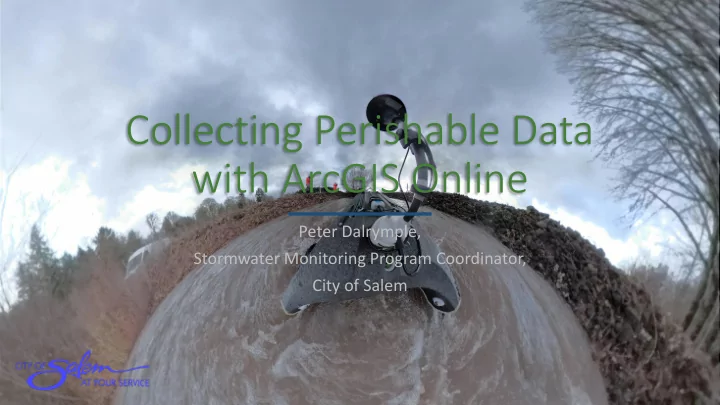

Collecting Perishable Data with ArcGIS Online Peter Dalrymple, Stormwater Monitoring Program Coordinator, City of Salem
Presentation Outline Part 1 - Setup use case • Purpose of the app • Description of the data Part 2 • Explain Application Structure and use issues • Improved usability with Arcade and ArcGIS Online Demo • Alternative data model: Survey123, Custom urls, Microsoft Flow
Part One – Use Case Background
• 40 inches of rain per year • 90 miles of streams • History of flooding
1996 2012 1960
Flood Warning System • 17 real-time stream gauges • Located throughout city and Mill Creek Watershed
Flood Warning System Cont’d • 16 real-time rain gauges • Located throughout city and Mill Creek Watershed
Hydrologic Model 4500 MC12 - Forecasted 4000 BC3 - Forecasted 3500 MC20 - Forecasted 3000 BEA3 - Forecast Time Forecasted 2500 Flow (cfs) 2000 HEC HMS 1500 Model Forecast inundation 1000 500 Projected rainfall, ground 0 12/15 12/16 12/17 12/18 12/19 12/20 12/21 12/22 Date saturation, snow conditions
What is Perishable Data? Documented observations of phenomena that are subject to rapid change and/or are useful for a limited time • Temporally significant • Must be collected quickly to be of use Mill Creek #3 , North Salem High School 15.00 Response 14.00 Value: Recovery 13.00 • Operational awareness/response Planning 12.00 • Post-event analyses Stage Height 11.00 • FloodStage Calibrate/verify flood models and inundation levels 10.00 9.00 Flood Threat Recognition 8.00 7.00 6.00 5.00
Operational Awareness Where is the water going? How will that affect flood impact? Will changes affect flood model projections? Diversion structure on Mill Creek @ Start of Shelton Ditch
Operational Awareness Field data inform Flood Warning System Operator Observations OC’d & Synthesized Shared with EOC as needed Flood Warning System F Operator i l t e r https://www.everbridge.com/blog/why-every-eoc-leader-needs-to-read-the-2018-nims-update/
What kind of Perishable Data are we interested in? Pictures and Date/Time Stamps!! Predefined locations of interest Ad Hoc Data Collection • • Bridges Street flooding • • Culverts Flood Damage • • Diversion structures Inundation Documentation • • Detention Basins High Water Marks/Wrack Lines Mill Creek #3 , North Salem High School 15.00 Flood Peak Response 14.00 Recovery 13.00 Planning 12.00 Stage Height 11.00 FloodStage 10.00 9.00 De-construct event Flood Threat Recognition 8.00 scenario to inform 7.00 future response 6.00 5.00
Calibrate/Verify Flood Model Mill Creek @ North Salem High School (MIC3) 14.00 Startof stream rise to breech of 13.00 HWW: 2.95" rain or 0.09" per hr. 12.00 With existing snow 3.58" or 0.11" per hr. 11.00 Stage (feet) 10.00 9.00 Stage (ft) 8.00 HWW (ft) Breech of HWW to peak stage: 7.00 2.92" rain or 0.10" per hr. 6.00 5.00 4.00 Mill Creek Begins to flood 21 st and State St (12 hours after Stage Alarm) • 10.1 ft. (raw) Mill Creek begins to flood 14 th and A St NE • 10.4 ft. (raw) Mill Creek floods State St. between 17 th and 24 th • 10.6 ft.(raw) • 11.5 ft. (raw) Shelton Ditch begins to flood Winter St. SE/Bellevue St. SE • 11.9 ft. (raw) Flooding on Turner Rd North of Kuebler Shelton Ditch begins to flood over 25 th St. SE • 12.2 ft (raw).
Request and Data Collection Needs • Received list from Flood Warning Operator of locations of interest and observations needed for each site • Developed Matrix to classify sites according to observation needs
Part Two – Application & Data Collection Structure
Build Schema, Publish Feature Services 1:Many Relationships for feature classes Observation Bridge Sites Bridge Observations Attachments Culvert Observation Culvert Sites Observations Attachments Detention Basin Detention Basin Observations Sites Observations Attachments Diversion Observations Diversion Sites Observations Attachments *Domain Values for validation ArcGIS Online
Build Web Map, Test Primary Complaint: Inability of Flood Warning System Operator to see which sites have been visited and how recently App needs to be fast and easy to use for non-technical end users
How can we call attention to the addition of related records? 1. Join parent feature layer to child table and create a new feature layer view 2. Place new join view below parent feature in TOC 3. Set refresh interval
Time-Aware Symbology 1. Add arcade expression to symbology for join feature layer view 2. Add arcade expression to symbology for join feature layer view 3. Pick outline that stays constant as fill changes with time
Time-Aware Transparency (Back to the Future Symbology) 1. Use same DateDiff arcade expression to set transparency based on time since last observation 2. Set Transparency values http://www.trgarts.com/TRGInsights/Article/tabid/147/ArticleId/346/Contextual-marketing-back-to-the- future.aspx?dnnprintmode=true&SkinSrc=[G]Skins%2F_default%2FNo+Skin&ContainerSrc=[G]Containers%2F_default%2FNo+Container
Related Inspection Records in Parent Feature Pop-ups • Access observations table using $datastore or $map and assign as a variable • Read site ID for current feature • Define SQL expression to filter the child observations table • Use SQL expression to filter the table • Perform a count to determine if number of records is greater than zero • Read out details if count is greater than zero Xander Bakker GeoNet Thread: https://community.esri.com/docs/DOC-12773-using-featuresetby-functions-in-arcade-to-drill-down-to-other-layers-and-tables
Related Inspection Records in Parent Feature Pop-ups • Add expression to pop-up configuration • Impress your friends….
Can we do even more?
Rethinking the use of multiple feature layers. These can be combined into one, unrelated survey layer. 1:Many Relationships for feature classes Observation Bridge Sites Bridge Observations Attachments Culvert Observation Culvert Sites Observations Attachments All Observation Survey Sites Pass values w/ custom urls (Stand Alone) (Stand Alone) Detention Basin Detention Basin Observations Sites Observations Attachments Diversion Observations Diversion Sites Observations Attachments *Domain Values for validation ArcGIS Online
Demo • Custom urls to launch Survey123 and pass parent feature values to survey • Webhooks and Microsoft Flow to send email notifications when new surveys meeting certain criteria are submitted • Use dynamic content from Survey123 in Microsoft Flow for url parameters to launch ArcGIS Online application, center, and zoom to newly submitted survey point
Peter Dalrymple pdalrymple@cityofsalem.net
Recommend
More recommend